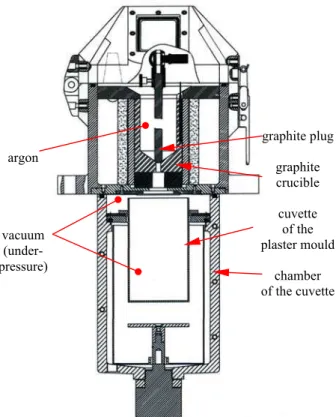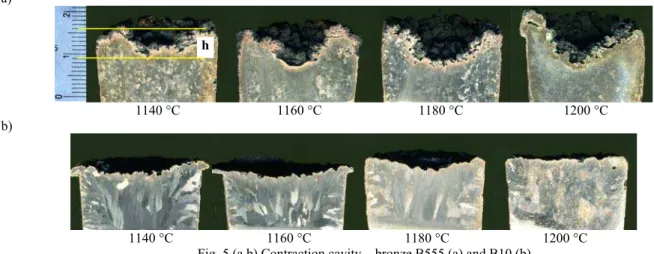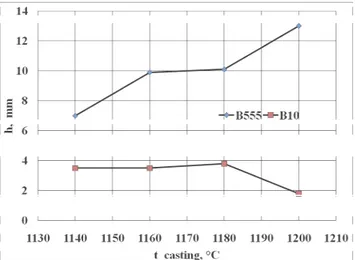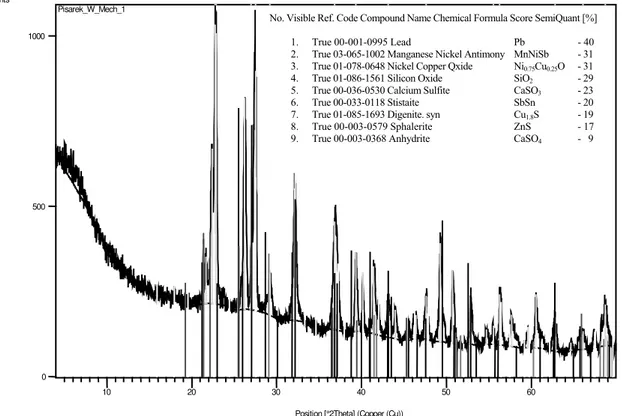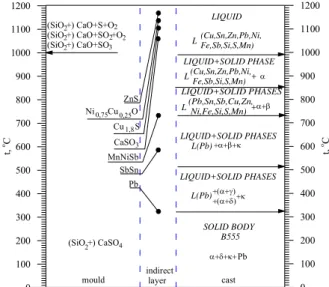A R C H I V E S
o f
F O U N D R Y E N G I N E E R I N G
Published quarterly as the organ of the Foundry Commission of the Polish Academy of Sciences
ISSN (1897-3310)
Volume 9
Issue 4/2009
203 – 208
37/4
Selection of the temperature of casting
the bronzes to plaster moulds
B. Pisarek*, M. Pawlak
Department of Materials Engineering and Production Systems, Technical University of Lodz,
1/15 Stefanowskiego Str., 90-924 Lodz, Poland
*Corresponding author. E-mail address: boguslaw.pisarek@p.lodz.pl
Received 25.06.2009; accepted in revised form 06.07.2009
Abstract
The results of the investigations of the process of solidification of the bronze CuSn5Zn5Pb5-C (B555) and CuSn10-C (B10) in the hot plaster mould show in the work. For four temperatures of casting: 1200 ° C, 1180 ° C, 1160 ° C and 1140 ° C was conducted the investi-gation: the size of contraction cavity, the fulfillment of the mould cavity formative the casts of test slats about the thickness: 4 mm, 0,8 mm and 0,5 mm. It was conducted the investigation the processes sets in the arrangement the cast-mould and X-ray analysis phase XRD of compound coming into being in indirect layer created among mould and cast in the result of the thermal decomposition of the anhy-drite.
It results that the temperature 1140 ° C is the optimum temperature of casting the bronze to hot plaster mould from carried out investiga-tions. The minimum thickness of the wall of the cast from the bronze B555 is 0.5 mm, and from the bronze B10 0.8 mm.
The realization of casts about thinner walls is made difficult because of giving off formed gases in the result of the thermal decomposition of the anhydrite. The products of the decomposition of the anhydrite react with elements steps in the chemical composition of studied bronzes, create in the arrangement the cast-mould the indirect layer folded from: sulphites, sulphides, oxides and clean metals (Pb) or their compounds, especially Sn and Sb.
Keywords: Innovative materials and casting technologies, Cast bronzes, Selection of the temperature of casting, Plaster mould, Thermal decomposition of the anhydrite, X-ray analysis phase XRD
1. Introduction
Developmental investigations over the optimization of the processes of the thermal processing of plaster moulds are led [1] and them dilatometric changes [2], how also the investigation of the process of the crystallization of bronzes in plaster moulds the method of thermal analysis and derivative (TDA) [3].
On precision as also art castings tin bronzes CuSn10-C (B10) and tin-zinc-lead CuSn5Zn5Pb5-C (B555) are applied [4]. These bronzes are resistant on corrosion, the abrasion and they can work in the raised temperature: 280 °C (B10) and 225 °C (B555). They are characterize good castability and machinability.
The decomposition of the anhydrite is one of problems connected
with their casting to plaster moulds in the temperature 1000-1100 °C according to possible reactions (1-3) [5]:
CaSO4=CaO+SO3 (1)
2CaSO4=2CaO+2SO2+O2 (2)
and then in the presence of oxygen (e.g. atmospheric):
SO2+1/2 O2=SO3 (3)
The content of the gas in the metal is inversely proportional to the content of dissolved in him compounds [4]. Active metals dissolve the least gases in the relation to oxygen (e.g. Zn), some-what more metals comparatively little active (e.g.: Cu, Ni), and the most metals little active in the relation to oxygen with the indissoluble oxide (e.g.: Sn, Pb).
2. Methodic of research
It the optimization of the process of casting the bronzes CuSn10-C and CuSn5Zn5Pb5-C was executed to hot plaster moulds with respect to the temperature their casting. The bronze was smelted in the casting machine of inductive INDUTHERM-VC 500D in atmosphere of argon (Fig. 1).
Fig. 1. Casting machine inductive INDUTHERM-VC 500D
The process of the melting of the bronze B555 and B10 in the furnace INDUTHERM-VC 500D characterizes oneself large efficiency (the short time of the melting). The small surface of the point of contact of the metal with argon limits to the minimum absorbing O2 or H2 through the bronze.
Bronzes after melting were overheated to the temperature suita-bly: 1200 °C, 1180 °C, 1160 °C and 1140 °C, and then the mould was casted - probe TDAg and plaster mould with thin-walled, so-called casts test slats about dimensions: the length L=100 mm, width A=15 mm, thickness B ={4,0.8,0.5} mm (Fig. 2). Plaster moulds were executed from the mixture PRIMA-CAST about the water-plaster relation 0.4. The solidification modulus of the sections of casts, shaped in the niches of the plaster mould imitat-ing test slats were qualified from example (4):
M=P/O, cm (4)
where:
M – solidification modulus of the section of the cast, cm,
P – cross-sectional area, cm2,
O – circumference of the cross-section, cm.
It carried out for individual thicknesses g of test slats suita-bly: g = 4 mm M = 0.158 cm, g = 0.8 mm M = 0.038 cm, g = 0.5 mm M = 0.024 cm.
g=0.8 mm
g=4.0 mm
g=0.5 mm
Fig. 2. Model of test slats
argon
vacuum (under-pressure)
graphite plug
graphite crucible
cuvette of the plaster mould
chamber of the cuvette
Moulds before the cast were subjected the three-stage thermal processing, enabling their dimension stabilization connected with phase transformations in the plaster. The program of the thermal processing of plaster moulds show on Figure 3.
In the aim of easier weighing the definite quantities of the charge, studied bronzes were subjected the granulation, being drowned cut up pieces of the pig sow of the bronze in casting machine, and then pouring out they liquid alloy to granulator full the water about the temperature 20 °C ± 2 °C.
The opinion of the influence of the temperature of casting on the size of the volumetric contraction, the studied grades of the bronze, it was conducted on the basis of the size of contraction cavity on section along the axis of the probe TDAg. The opinion of processes setting on the surface of plaster mould and liquid bronze was conducted on station showed on Figure 4. Cylindrical samples were used to investigations, from the studied grades of the bronze, about dimensions Ø= 7 mm and h = 7 mm. The sam-ples were smelted in the stream of plasma, created among elec-trodes graphite and tungstic, in the protection of argon.
0 1 2 3 4 5 6 7 8 9 10 11 12 13 14 1
, h
5 0
100 200 300 400 500 600 700 800
t,
C
4h 6h min 3h
τ
200 C
720 C
500 C
In the aim of the phase identification of compounds coming into being on the surface of the plaster mould, in the consequence of reactions setting between the products of the decomposition of the anhydrite and elements in the composition of the bronze, the analysis XRD was conducted on X-ray microanalizer. Investiga-tions were conducted for the angle 2Θ from 4.0014 to 69.9784 with the step what 0.0170. Anode Cu and radiation were applied: K-Alpha1 [Ĺ] 1.54060, K-Alpha2 [Ĺ] 1.54443, K-Beta [Ĺ] 1.39225, K-A2 / K-A1 Ratio 0.50000 and setting of the generator 30 mA, 40 kV.
Fig. 4. Station to the investigations of processes setting on the surface of the mould under the influence of the liquid bronze
3. The results of investigations
The pictures of the contraction cavity of the bronze B555 and B10 show on the Figure 5 (a, b), and the change of her depth in
dependence from the temperature of casting the bronze to the mould on Figure 6. From the introduced cross - section of casts from the probe TDAg, it results that it together with considerably grows up the depth of the contraction cavity with the growth of the temperature of casting, and what joins with this executed along its axis the volumetric contraction grows up, especially bronze B555 (Fig. 5a and 6). The bronze B10 is characterizes considerably smaller volumetric contraction (Fig. 5b and 6), however overheated 1180 °C above and cast to the hot plaster mould, in the conditions of the atmospheric pressure, it undergoes strong gassing with what considerable decrease of the depth of the contraction cavity joins (Fig. 5b 1200 ° C and Fig . 6). Zinc as high active metal in the relation of oxygen influences the lower-ing of the content of gases dissolved in the bronze B555. Consid-erably larger content Zn in the chemical composition of the bronze B555 (approx. 5%), in the comparison with the bronze B10 (to 0.5 %), it favours creation on the surface of the solidifica-tion bronze of the layer of oxides Zn and Cu, in the composisolidifica-tion natural slags about the smaller mass density from the liquid bronze, making difficult chemical adsorption and dissolving the hydrogen and oxygen in the liquid bronze. Bronze B10 including first of all the admixture approx. 10% Sn, element of little active in the relation to oxygen, it absorbs from surroundings highly both the hydrogen as and the oxygen, what it brings in the conse-quence, together with the growth of the temperature of casting, to gassing the bronze.
On the Figure 7 (a, b) the pictures of test slats show about the thickness (from left): 0.8 mm; 4 mm and 0.5 mm; suitably for the bronze B555 (and) and B10 (b). Slats about the thickness 0.8 mm and 4 mm was casting from both studied grades of the bronze from the temperature of casting independently.
a)
1140 °C 1160 °C 1180 °C 1200 °C
b)
1140 °C 1160 °C 1180 °C 1200 °C
Fig. 5 (a,b) Contraction cavity – bronze B555 (a) and B10 (b)
Only for the temperature of casting 1140 °C was got, for the bronze B555, full casts of three test slats. Because of the increas-ing the speed of the decomposition of the anhydrite, together with the growth of the temperature of casting the bronze to the plaster mould, the gases pressure of coming into being in the result of this process is on so many large that this causes, for the thin cross-section of the cavity of the mould (thickness of the test slat
0.5 mm) the considerable resistances of flowing the bronze, together with the stop of the process of filling the cavity of the mould. This is caused probably these, that the quicker growth of viscosity of the crystallizing bronze, in the section of the cavity about the smallest solidification modulus, resulting from the smaller quantity of heat to accompanying by the mould, it influ-ences decrease of the castability of the bronze in the comparison graphite
electrode
tungstic electrode plaster
sample bronze
cylindrical sample
with thicker cross-section considerably. The speed of emission in the process of the decomposition of the anhydrite of gases (O2 and SO2) on the surface of the hot cavity of the plaster mould probably is larger the than speed carry off them through the wall of the mould, and the weight of poured bronze to the cavity of the mould, about the smallest thickness, it is insufficient to push out unpump from this space of gas.
Fig. 6. Change of depth (h) of contraction cavity in dependence from the temperature of casting (t_casting) of the bronze
Visible whirls of the front of the stream of the metal of filling the slats about the thickness 0.5 mm they are called out the
proba-probably local break come into being on the front the stream of oxides enabling more far filling the space of the cavity of the mould. The areas in which the larger quantities of gases coming into being in the result of the decomposition of the anhydrite are accumulated can also be this isolate from the liquid bronze the oxide membrane.
Characteristic for the bronze B10 is formation of considerable stress in the process of solidification, what he brings to hot crack-ing in the consequence. Test slats about the thickness 0.8 mm and 0.5 mm cast from the temperature 1140 °C above are crack in the part or on the whole section.
The view of the drop of the solidification bronze on plaster mould and the fragments of plaster mould from the side of the contact with the melted drop show on Figure 8. Conducted analy-ses on station to the investigations of procesanaly-ses setting on the surface of the mould under the influence of the liquid bronze, in the normal weather condition of surroundings confirm that the considerable quantity of gases gives off in the process of the decomposition of the anhydrite. The large quantity of gas cavities testifies about this inside the drop of the solidification bronze on the surface of the plaster mould and characteristic shape and the colour of the surface of the plaster mould under the drop.
On the plaster mould remaining the compounds whose green colour testifies about the presence in them first of all sulphurs. The indirect layer separates the anhydrite from the drop of the metal it is not continuous and contains the row of cavity after gas cavities.
a)
1140 °C 1160 °C 1180 °C 1200 °C
b)
1140 °C 1160 °C 1180 °C 1200 °C
View from the top
View of drop of bronze melted on
plaster surface, magnify. 1:1
View from the bottom
Magnify. 1:1
View of the surface of the plaster mould
under the drop
Magnify. 3:1
Fig. 8. View of the drop of the solidification bronze on plaster mould and the fragments of plaster mould from the side of the contact with the melted drop
These cavity are considerably smaller in the comparison with formed in the drop of the bronze.
The results of the X-ray phase analysis of chemical com-pounds show in the indirect layer under the drop of the bronze B555 on the drawing 9. The presence was identified on the basis of preliminary investigations method XRD in layer this except the anhydrite CaSO4 probably sulphites CaSO3, sulphides ZnS and Cu1.8S, oxides simple SiO2 and complex Ni0.75Cu0.25O, pure Pb and the compounds of metals SbSn, if also MnNiSb. The probable order formation of compounds in the indirect layer for
the arrangement the cast (B555) - mould (CaSO4+SiO2) in the function of the temperature their of creating show on Figure 10. The probability of the occurrence of exchanged compounds results from the chemical profile of elements, i.e. from their susceptibility to joining oneself with oxygen or different ele-ments. The most active calcium creates the oxide about the high-est heat of creating, and now about the highhigh-est temperature of the decomposition. In the range of the temperature of casting, CaO stays undecomposed.
Position [°2Theta] (Copper (Cu))
10 20 30 40 50 60
Counts
0 500 1000
Pisarek_W_Mech_1
No. Visible Ref. Code Compound Name Chemical Formula Score SemiQuant [%]
1. True 00-001-0995 Lead Pb - 40
2. True 03-065-1002 Manganese Nickel Antimony MnNiSb - 31
3. True 01-078-0648 Nickel Copper Qxide Ni0.75Cu0.25O - 31
4. True 01-086-1561 Silicon Oxide SiO2 - 29
5. True 00-036-0530 Calcium Sulfite CaSO3 - 23
6. True 00-033-0118 Stistaite SbSn - 20
7. True 01-085-1693 Digenite. syn Cu1.8S - 19
8. True 00-003-0579 Sphalerite ZnS - 17
9. True 00-003-0368 Anhydrite CaSO4 - 9
They came into being the dioxide of sulphur in result of thermal decomposition CaSO4 (equation 2) what breaks up in this tem-perature on S and O2 creation of sulphides and the oxides of metals makes possible. The renewed connection of sulphur to-gether with dropping the temperature follows with oxygen in the SO2 which reacting with CaO CaSO3 creates. SiO2 is also the component of the mass PRIMA-CAST, from here his presence in the indirect layer. The bronze B555 is characterizes the wide range of solidification (temp. liquidus approx. 996 °C, temp . solidus approx. 326 °C). Solidification in this wide range his microstructure crosses the row of the phase transformations whose temperature were marked arrows on Figure 10. Com-pounds creators of the indirect layer were ranked according to the estimated range of the temperature their creating. Tin and anti-mony are characterize limited dissolubility in the copper.
0 100 200 300 400 500 600 700 800 900 1000 1100 1200 t, oC 0 100 200 300 400 500 600 700 800 900 1000 1100 1200 t, oC
(SiO +) CaO+S+O (SiO +) CaO+SO +O
(SiO +) CaO+SO2
2 2 2 2 2 2 4 3 LIQUID (Cu,Sn,Zn,Pb,Ni, Fe,Sb,Si,S,Mn) LIQUID+SOLID PHASES L(Pb) LIQUID+SOLID PHASE (Cu,Sn,Zn,Pb,Ni, Fe,Sb,Si,S,Mn)L +α
L LIQUID+SOLID PHASES L(Pb) SOLID BODY B555 +(α+γ) +(α+δ)+κ LIQUID+SOLID PHASES (Pb,Sn,Sb,Cu,Zn, Ni,Fe,Si,S,Mn)
L +α+β
+α+β+κ
α+δ+κ+Pb ZnS
Ni Cu O0,75 0,25
Cu S1,8
Pb MnNiSb SbSn CaSO3
(SiO +) CaSO
mould cast
indirect layer
Fig. 10. The order formation of compounds in the indirect layer for the arrangement cast(B555)-form(SiO2+CaSO4)
These elements undergo strong microsegregation and „pushed aside” in front of the front of crystallizing phase α. Their concen-trations occur the largest in solidifying phase from the liquid bronze being in interdendritic spaces, crystallizing in the tem-perature about 500 °C, from here also similarly as and lead, crys-tallizing as last phase in the temperature about 326° C, they probably can flow in to the creating indirect layer still in the liquid state.
The more far investigations of the process of casting the bronzes to hot plaster moulds should aim to the study of the covering for wax models, thin-walled casts, reducing the direct contact of the liquid bronze with the anhydrite, and in the conse-quence delay of the process of the thermal decomposition of the anhydrite.
4. Conclusions
From carried out investigations, in the reference to the bronze solidifying in hot plaster mould, following conclusions result:
• the bronze B555 is characterizes the considerably larger volumetric contraction than the bronze B10,
• in the cast from the bronze B10, in the result of the process of crystallization and cooling down in the solid state, calling out the fragility hot considerable internal stress occur - cracking the thin walls of the cast,
• the anhydrite in the contact with the liquid bronze, in the range of the studied temperature of casting moulds, under-goes the decomposition, mainly on gas compounds,
• the products of the decomposition of the anhydrite react with the elements of the liquid alloy, create in the arrangement the cast-mould the multiple indirect layer,
• the indirect layer consists probably of the sulphite of cal-cium CaSO3, sulphides ZnS and Cu1.8S, oxides simple SiO2 and compound Ni0.75Cu0.25O, pure Pb and the compounds of metals SbSn, if also MnNiSb,
• the increment of the temperature of casting the bronze to the mould does not influence on enlargement the length flood of thin sections because of the growth the quantity the gases fills the cavity of the mould and makes difficult her flood, coming into being in the result of the thermal decomposition of the anhydrite,
• the temperature 1140 °C is the optimum temperature (from the studied range) of casting the bronze to hot plaster moulds,
• the casts, from the studied grades of the bronze, should not have the smaller wall than: from the bronze B555 of gmin=0.5 mm and from the B10 of gmin=0.8 mm.
Acknowledgements
The work was made as a part of the research project No. N N508 3886 33 financed by funds for science in the years 2007-2010 by the Polish Ministry of Science and Higher Education
References
[1] M. Pawlak: Influence of temperature and time of firing on the properties of gypsum. Research in Polish Metallurgy AT the Beginning of XXI Century. Committe of Metallurgy of the Polish Academy of Science, AKAPIT, Cracow, (2006), 287-293. (in Polish)
[2] M. Pawlak, Z. Niedźwiedzki: Dilatometric studies of plaster sandmix in raw and heat treated state, Archives of Foundry, Polish Academy of Science, 2008, Vol. 3, N° 8, 145-148.
[3] B. Pisarek, M. Pawlak: The thermal analysis and derivative bronzes cast to plaster moulds, Archives of Foundry Engineering, Vol. 9, Issue 3, June 2009, 159-168.
[4] Z. Górny, J. Sobczak: Modern casting materials on the base of non-ferrous metals, ZA-PIS, Kraków (2005).
(in Polish)
